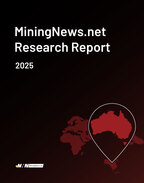As part of ongoing feasibility studies, AVL has been able to boost tonnages 15% to 239 million tonnes at 0.73% vanadium pentoxide.
That includes 38.8Mt at 1.1% for the known high-grade measured and indicated resources, with a total high-grade resource up 8.6% to 95.6Mt at 1.07%.
The company analysed new rock density information to deliver the upgrade.
Managing director Vincent Algar said vanadium-titanium-magnetite deposits displayed a clear correlation between iron content and density, so measurements were important to estimate resources and derisk the processing flowsheet.
The company is finalising a bankable feasibility study for plans to develop a mine and concentrator near Meekatharra, and a downstream processing plant Tenindewa, near Geraldton, in the Mid West region.
Algar said many key parts of the BFS and approvals process were being ticked off, as the company starts to move towards project validation, funding, and development.
AVL recently completed an A$8.7 million placement, and was awarded a $3.7 million grant under Canberra's Modern Manufacturing Initiatives to help it advance studies for its processing plant, a commercial vanadium electrolyte plant, and the manufacture of residential and stand-alone power systems in WA.
The company says its Australian Vanadium project has the potentially to be a globally significant producer at a key time in global markets for the metal.
AVL not only has in-house battery interests, but has developed a mechanical water leach circuit has it believes can deliver premium vanadium products using a cost-effective design.
The pelletised concentrate also comes with significant iron and titanium by-products.
Earlier studies gave the project a reported capital cost of around US$400 million, but will generate an expected 24.3 million pounds of vanadium and 900,000t of co-product annually.
The company hopes to be in production before early 2024.
AVL shares have traded between A1-3.6c over the past year, and were off 2% to 2.3c today.



